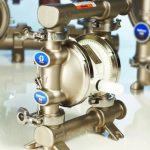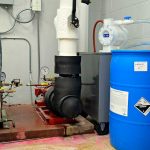We already know that pneumatic diaphragm pumps have an excellent cost-effective for companies, mas qual o seu custo ao longo de todo o seu período de utilização? Esses equipamentos são conhecidos pela sua alta versatilidade e confiabilidade, podendo lidar com fluidos diversos e possuindo um preço de compra baixo. Além disso, essas bombas também não exigem muitos reparos e pausas para manutenção.
Se está nos seus planos adquirir uma bomba pneumática de diafragma (e deveria estar!), preparamos algumas dicas para te ajudar a se planejar financeiramente. Confira a seguir!
6 fatores fundamentais que afetam o custo de uma bomba pneumática de diafragma durante seu ciclo de vida
1. Preço de compra inicial
This is the first cost of your pneumatic diaphragm pump. As it can be found in different sizes and configurations, the price may vary slightly, but in general it is a more economically interesting option than other alternatives available on the market.
2. installation cost
Due to their simple configuration, the pumps have a low maintenance cost. This is possible for the following reasons:
• Does not require electricity to function, eliminating a nearby power source;
• No laser alignment or other special requirements are required when installing;
• All that is needed is an air supply, a few flexible fluid connections, and a basic valve in the pumps' inlet and discharge lines so they can be isolated for removal from service for repair and maintenance.
3. Appropriate sizing
In order to deliver greater efficiency and service life, the correct sizing of the pneumatic diaphragm pump is essential. For example, if you want to pump 40 gpm (151 lpm) with 3 meters of head, most pumps on the market can achieve this flow by pumping water. Unfortunately, the pump would have to work close to its maximum capacity and stroke rate, leading to increased component wear and reduced efficiency.
Upgrading to the next size, you can run the pump significantly slower (reducing costs per minute), which will extend the life of the pump and increase its efficiency (with reduced compressed air consumption). The difference in initial purchase price between the two sizes is not significant, and this choice allows the cost difference to be quickly offset in longevity and efficiency.
4. Pump material
The choice of pump material is critical in determining its cost and durability. The first step is to verify that the fluid being pumped is chemically compatible with the pump material. To verify this type of information, consult your pump manufacturer's chemical compatibility guide.
Second, once you've selected the right material, determine what will offer the best lifespan at the best price. For example, if you want to pump sodium hydroxide, polypropylene and PVDF can be used for the pump body wetted materials, but PVDF costs significantly more than polypropylene.
5. Repairs: Complete Components Vs Individual Components
The cost of repairing a pneumatic diaphragm pump should take into account a number of factors:
• Process Downtime: When a pump is out of service, you must consider the cost of lost production. This is usually the most expensive part of a repair, more so than the maintenance itself. Many companies have replacement units that can be exchanged quickly, minimizing downtime and lost production.
• Repair labor cost: Costs associated with maintenance staff can be considered, but often these individuals are already on the payroll. For pneumatic diaphragm pump repairs, many companies choose to have local distributors service their pumps if they don't have the staff to handle the repairs.
• Safety/environmental cost: When a pump fails, it is likely that some of the pumped product will need to be cleaned. In some cases, the spill will simply be water. But in some cases, the product will be a chemical or liquid that cannot be flushed down the sump or drain. In this regard, maintaining the pump and working to a preventative maintenance schedule are great ways to reduce costs and downtime.
• Cost of repair parts: Replacement parts are usually a small part of the overall repair costs. To reduce costs and downtime, “full” maintenance is recommended. That means replacing all critical components instead of just the parts that fail. It's a cost-effective strategy that almost always saves you time and money, helping to reduce the likelihood of future failures.
6. Cost of consumption
As we have seen, the pneumatic diaphragm pump does not need electricity to operate, with compressed air being its only consumption. In this sense, controlling the pump's air supply can make it more economical and efficient. The use of certain accessories, such as a liquid level controller, prevents the pump from running dry when a tank or sump is empty – this saves compressed air, which saves money.










